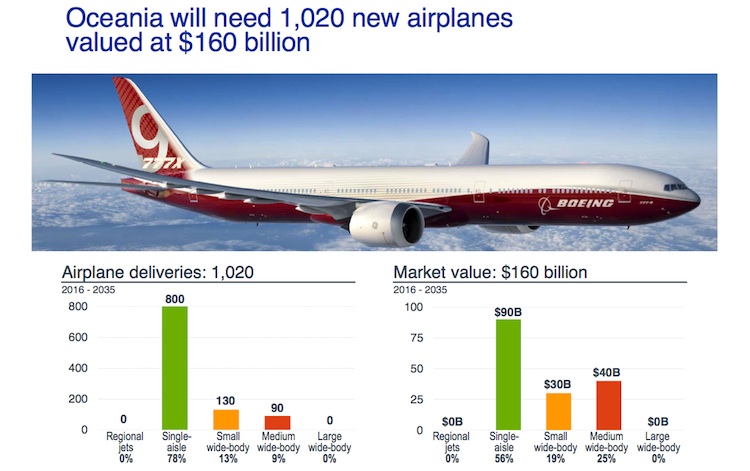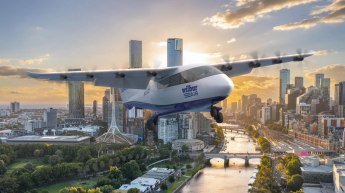
Boeing has upgraded its forecasts for new aircraft orders in Oceania for the next two decades as airlines in the region replace older models with newer, more fuel efficient jets and shy away from large widebodies such as the 747-8 and Airbus A380.
The manufacturer’s outlook is for airlines in the region – Australia, New Zealand and the nations of the South Pacific – to order 1,020 new aircraft worth $US160 billion over the next 20 years.
The estimate, contained in Boeing’s Current Market Outlook (CMO) for 2016-2036, is an increase of 70 aircraft from the 950 expected for Oceania in the 2015-2034 CMO.
Two of the five aircraft categories – single aisle and medium widebody – were higher than the prior year.
By contrast, the latest CMO cut the forecast for the regional jets segment, which Boeing does not compete in but offers a forecast for, and large widebody segment (more than 400 seats) to zero. The estimate for small widebody (between 200-300 seats) orders was also reduced.

Boeing Commercial Airplanes senior vice president for sales in Asia Pacific and India Dinesh Keskar said very large aircraft such as the passenger variant of the Boeing 747-8 and Airbus A380s were not required for airlines in the region.
Rather, airlines were likely to grow through adding new frequencies on existing routes and opening new markets rather than flying larger aircraft.
“We don’t think an airplane like the A380 would be needed in that market going forward,” Dr Keskar told reporters on the sidelines of the Association of Asia Pacific Airlines (AAPA) annual gathering in Manila on Friday.
“In fact Qantas is dealing with a situation where they have deferred their A380s and we don’t think in that market anybody is going to touch the A380.”
Boeing has regarded the very large aircraft segment as a small market, believing just a handful of airlines around the world had the route structures and capabilities to successfully utilise an aircraft with more than 400 seats.
Sales of both the A380 and 747-8 have been slow.
The A380 ended a three-year order drought earlier in 2016 when ANA said it would purchase three of the type and Iran Air indicated it would purchase 12.
Meanwhile, Boeing has reduced the production rate of the latest version of the 747, reflecting both the lack of demand for very large passenger aircraft and the weakness in the global cargo market.
Boeing expected the Oceania fleet to increase from 520 to 1,050 over the next 20 years, with some 520 aircraft replaced and 500 new aircraft joining the fleet for growth. Just 30 aircraft flying today will still be in the skies in two decades’ time.
Dr Keskar noted the average age of the fleet in the region had fallen from about 19 years in 2005 to 15 years in 2010 and 10 years in 2015.
“That is a significant improvement,” Dr Keskar said.
“The fleet modernisation is continuing.”
















Michelle
says:Interesting views…
A380 is a great volume airline markets like USA and high population. This part of world is more speed rather then volume. Qantas is a good example airline personally I would not gone for a380 for qantas. Perhaps a couple. Great to see qantas finally starting with the 787. The Boeing 777 is good aircraft but rather preferre 787
Flying on 777 BA FROM SYDNEY TO UK BY end of the flight you glad it is over regardless what class you travel
I do love Boeing way better on design and style. In saying that the a380 is a fantastic volume aircraft
Frequent Traveller
says:A380 will eventually come into its own by far the most comfortable widebody out there choose it every time over the competition.
Patrick Kilby
says:It is worth noting that to Boeing it seems the 777-9 is not regarded as a large aircraft or is it they do not they can sell any in this part of the world. A very odd analysis from a company that spruiks its very large aircraft. The 777-9 has a greater capacity that the 747-400
Bruce
says:With air travel doubling in the next 15 years there is and will be in the future a need for VLA aircraft such as the A380, particularly between mega cities. I travel regularly between Europe and Australia/NZ and for the passenger there is no comparison between the A380 and B777. In economy the standard B777 seating is now 10 abreast and extremely uncomfortable for flights over 14 hours duration to the Middle East. I recently flew business class Guangzhou to Auckland on a brand new B777 business class and while spacious and comfortable the noise in the cabin from air conditioning and aerodynamic was terrible and really unacceptable in todays age of A380, B787 and A350. I always try and chose the A380 for travel to and from Europe whether traveling either economy or business as it is so much more comfortable and enjoyable. Currently in addition to Qantas other airlines including Emirates, Etihad, Qatar, Singapore and China Southern use A380 equipment to Australia and NZ so there is a need and a demand.
That Ron guy
says:Nice of Boeing to tell all the airlines in the region that they don’t need the A380. I’m sure Airbus appreciated that.
Sales forecasts for production & shareholder guidance are one thing, but when they’re preached to the market like this, it’s more a case of marketing than forecasting. Whether the forecasts are accurate or not is beside the point. They’re telling the market however what they “want” to buy. Or more precisely, what Boeing wants to sell. They know the 747 is dead, so they have to push the market for everything else.
Dee Thom
says:Agree with Michelle, what Airbus need to do is utilise more lightweight material, and have their engine providers lower the fuel usage by say 25% and then the sales of A380’s will rise for an excellent airframe, which is still noise friendly, unlike some Boeing products.
Tony
says:Recognise this article is more about Boeing marketing not just a statistical analysis. However only 51 aircraft per year seems very low. How many aircraft are currently flying in Oceana? Also only 25 new additional aircraft are predicted per year.
The references to the A380 seem to be all marketing spin. When will the USA order any for their region? It seems never due to false nationistic pride. When they rejected the A330 tanker for the 767, few realised that the US content was higher in the A330 than the supposedly US built 767.
random
says:The rejection of large aircraft would seem to be at least in part relative to the ill-feeling towards hub operations by passengers, & airlines trying to cater either through more frequencies or more direct routes.
It seems odd however that Boeing has not moved on its Middle of Market (MoM) aircraft – an aircraft which would seem to be in a payload & range class currently under-exploited – but which the analysis & marketing produced here seems to support.
Airbus A321LR NEO is being pitched at that MoM category – right in between “Single aisle” & “Small Wide-body” categories – the two largest cohorts by aircraft delivery in the graphics. Boeing is yet to commit to B737MAX10, has all but ruled out revising a warmed-up modernized B757, & seems to have baulked at a new aircraft where development costs would be considerable.
Will be interesting to see where this story goes for the manufacturers & airlines, & if an aircraft comes along (Airbus or Boeing) that gives carriers the impetus to break the hub mentality that pervades local international services.
Red Barron
says:Written by Boeing for Boeing. Obvious their views would be directed at their own aircraft. I too prefer flying the A380 and will often seek it out when searching for flights.
Tony
says:Thinking about the MoM decision, the A310 seems to meet the criteria. Long range, right size. Maybe Airbus should consider an A310 neo? Will not happen of course but the wing box design of the early Airbus was integral with the body rather than under. Gave a good aerodynamic shape. Put that with a new wing or at least winglets and they have a 757 beater!
Peter J Cesnik
says:Whilst this smacks on Boeing promotion the A380 and B747 are to large units to economically fit into the island hopping. Still A380 is a marvel although B747-8 is till the king in certain areas…